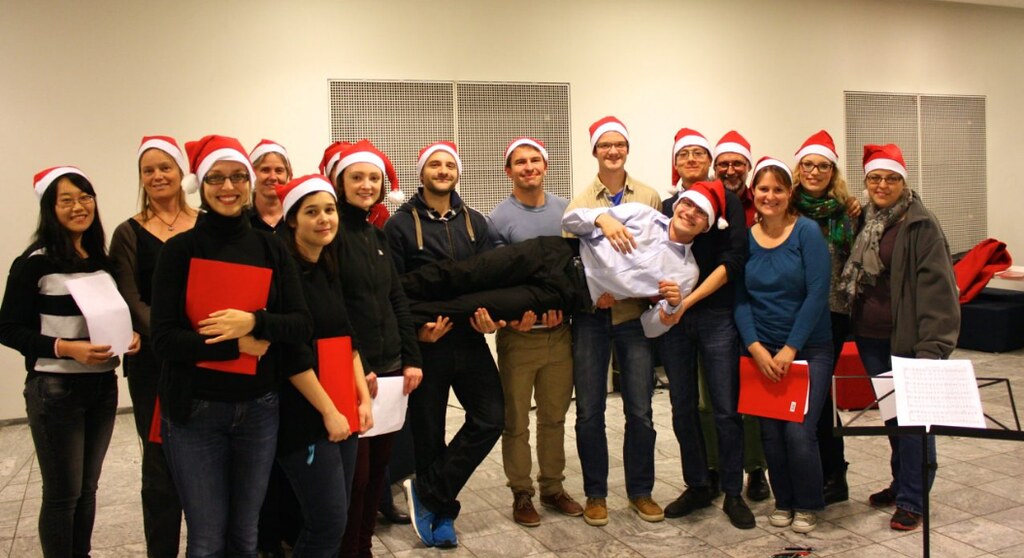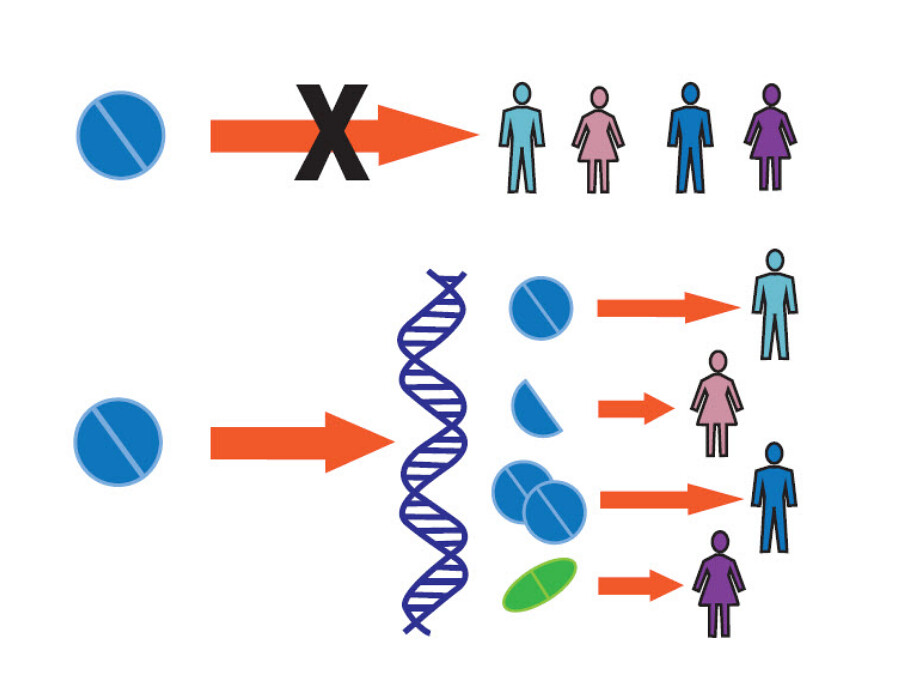Source: Uniavisen
Just coming off of the holidays over two months ago, the image above is still fresh in our minds. Of course, the next major holiday is probably not winter but sunshine -- Summer. The thoughts of beaches and sun blazing down on the water while surfing, swimming, or just straight chillin' on the beach. My point is that when I mention a scientist singing a song, the above picture is a common place to project that image. But what about in a rock band? Or a music band in general? Not common right? Wrong.
You would be surprised at the amount of scientists who also are associated with a musical instrument or an art project/hobby. Scientists are notorious for engaging in artistry of some sorts -- whether that be from playing in a band or painting a picture to designing the next generation of skin care make up. Art plays a prominent (although scientists may not like to admit this fact) role in science.
With all of this being said, the Director of the National Institutes of Health recently was interviewed in an article titled "For Scientists About to Rock (We Salute You)" to discuss his next love to science -- which is making music:
Science and music are closely connected. Says Dr. Francis Collins, director of the National Institutes of Health (NIH): “Whether you’re working with another person or a whole team of people who have different skills, different dreams and different aspirations and you put them together, you create something magical. Science does that and so does music.”Collins, a physician-geneticist, is noted for his landmark discoveries of disease genes and his leadership of the international Human Genome Project, which culminated in April 2003 with the completion of a finished sequence of the human DNA instruction book. He served as director of the National Human Genome Research Institute at the NIH from 1993 to 2008. He was appointed the 16th NIH director by President Barack Obama and was confirmed by the Senate in 2009.When Collins came to the NIH, he was concerned that his passion for music would take a backseat to science. He soon learned about The Directors, a band consisting of former NIH senior staff. The name changed to the Affordable Rock ‘n’ Roll Act (ARRA) and everyone at the NIH is welcome to join.The name’s not political. It stems from being affordable, “since we don’t get paid for performing,” Collins said.
To read the remainder of the article - click here. Dr. Francis Collins is a multifaceted kind of man. He is engaged in all sorts of activities ranging from playing in music bands to practicing christianity. Yes, Dr. Collins is a christian. This comes as a great surprise to most scientists who meet or interact with Dr. Collins. Typically, the thought is at odds with conventional science, but Dr. Collins states not so obvious.
The spectrum of scientists is wide and all encompassing. In fact, there are more religious people than the non-scientist might expect in science. Although, most do not speak out in favor of religion for fear of professional disqualification. Yes, that would be highly illegal, but the reality is that is the truth. Great scientists such as Dr. Collins manage to live in both realms without any difficulty or controversy. Anyone can view Dr. Collins 'CV' -- Curriculum Vitae here.
Back to his true passion of singing. Below is a song written by Dr. Francis Collins about 'Personalized Medicine':
For those who do not have the bandwidth to listen to the song, I show the transcript below for you to read:
00:05 I put these here just in case well Susan
00:13 can be blamed for this because she
00:17 suggested that you all were of the sort
00:19 that might actually adjust to a little
00:22 bit of foolish singing at the end and
00:24 that's the only kind of singing I do so
00:27 so uh this is a song about the future
00:31 personalized medicine remember I said
00:37 that thousand dollar genome is coming
00:39 pretty soon and that means each of you
00:42 each of you will have the chance maybe
00:44 in the next five or six years to have
00:46 your entire genome read out all six
00:49 billion of those letters of your DNA
00:51 code and then you'll have to figure out
00:54 what it means and that's a bit of a
00:57 challenge a few people have already gone
00:59 through this experience and they've been
01:01 a little flummoxed
01:02 trying to make sense of the data well we
01:05 will all be so this is a song that you
01:08 could imagine yourself having just
01:10 received your genome basically you're
01:14 sitting in front of your computer you're
01:16 sort of scrolling through the pages and
01:19 what do you see a lot of AC GMT in
01:23 various orders and trying to figure out
01:25 exactly what does this mean so this is
01:29 your song and I need a little help on
01:31 one part of this song because it goes up
01:35 to a high C sharp that's a little
01:38 outside my normal range you will you
01:41 will feel it coming and and you will
01:45 help me I sure hope anyway you'll know
01:48 what you have to do
01:50 so here's the song of looking at your
01:52 genome as I walk along the pages in all
02:00 six billion places upon my computer
02:05 screen am I built for strong endurance
02:13 or loss of life insurance am i a mere
02:19 machine
02:23 I'm a walking through the genes don't
02:27 know what all this means
02:30 again the meeting be behind that gmt and
02:36 i want to help me out
02:42 why why why why why you've got an a I've
02:48 got a see there what does that say
02:54 amazing DNA at EDD
03:11 so I'm glad to know I've got some of
03:15 what Crick and Watson found and brought
03:20 them say use your own imagination
03:28 despite variation we're really much the
03:33 same
03:34 I will walk in through the genes don't
03:40 know what all this means
03:42 Oh what can the meaning be behind that
03:47 G&T; I wonder why why why why why why
03:58 you've got a G I've got a see there what
04:03 does that say
04:06 amazing DNA a dee dee dee dee da dee dee
04:12 DNA a DDD DNA
04:37 you
Wow! As I just stated, the spectrum of scientists is wide and all encompassing. All types of people in life do science. In addition, all types of people make up scientists. If you take a look at Dr. Collins long and successful career, you will notice the extent (a large amount) he has pushed the edge of research. Currently, he is the director of the National Institutes of Health.
The song above is about a current enormous project called "All of Us" by the National Institutes of Health. A few months ago, I wrote a blog post about the unveiling of the enormous program which aims to push the medical field toward precision medicine. Precision medicine stands to hone in on individual treatments by teasing out individual differences in treatment/diagnosis, disease pathology. Why do people have different forms of cancer? What is attributed to these differences in medical diagnosis? What is the difference between two patients with a seemingly similar form of cancer? Is the cancer the same or different? How do the treatment of both patients differ?
Medicine is moving along a trajectory which is exciting and will reveal new medicine in the future. We need as many different types of people engaging in science, technology, engineering, and mathematics (STEM) fields to help further science. On the patient side, the "All of Us" trial needs as many volunteers as possible to expand the diversity in disease treatment and diagnosis. This will require different people (ethnic, gender, cultural, etc.) participating as volunteers along with a highly diverse group of scientists processing the trial and gathering the data. This is a time of celebrating the differences among us, not just as scientists but as human beings.
The song above is about a current enormous project called "All of Us" by the National Institutes of Health. A few months ago, I wrote a blog post about the unveiling of the enormous program which aims to push the medical field toward precision medicine. Precision medicine stands to hone in on individual treatments by teasing out individual differences in treatment/diagnosis, disease pathology. Why do people have different forms of cancer? What is attributed to these differences in medical diagnosis? What is the difference between two patients with a seemingly similar form of cancer? Is the cancer the same or different? How do the treatment of both patients differ?
Medicine is moving along a trajectory which is exciting and will reveal new medicine in the future. We need as many different types of people engaging in science, technology, engineering, and mathematics (STEM) fields to help further science. On the patient side, the "All of Us" trial needs as many volunteers as possible to expand the diversity in disease treatment and diagnosis. This will require different people (ethnic, gender, cultural, etc.) participating as volunteers along with a highly diverse group of scientists processing the trial and gathering the data. This is a time of celebrating the differences among us, not just as scientists but as human beings.
Related Blog Posts:
NIDA Director Nora Volkow: How Health Communicators and Journalists Can Help Replace Stigma with Science
Want To Improve Science Communication: Add Artists!
Should you consider science while before voting next Tuesday?
NIH Director Francis Collins Makes A Statement Regarding Sexual Harassment In Science
"All Of Us" - The Best Medical Knowledge Update Effort - Please Join!
What Is Going On Inside That Cell?
Thoughts: What Does National Institute of Health Director Francis Collins get asked in front of Congress?
Want To Improve Science Communication: Add Artists!
Should you consider science while before voting next Tuesday?
NIH Director Francis Collins Makes A Statement Regarding Sexual Harassment In Science
"All Of Us" - The Best Medical Knowledge Update Effort - Please Join!
What Is Going On Inside That Cell?
Thoughts: What Does National Institute of Health Director Francis Collins get asked in front of Congress?


